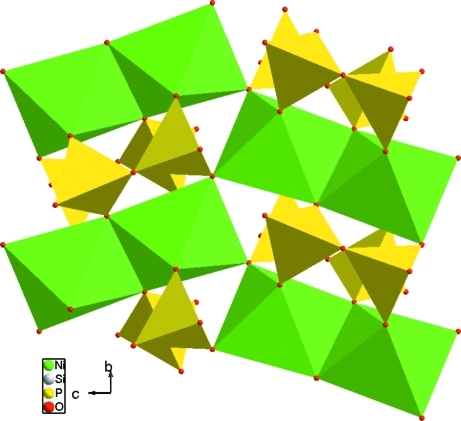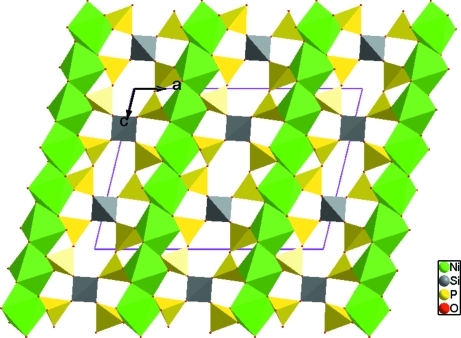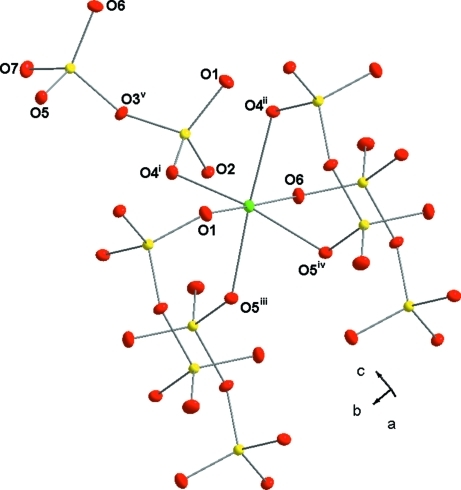Abstract
Dinickel(II) silicon bis[diphosphate(4−)], Ni2Si(P2O7)2, is isotypic with other phosphates of the formula M 2Si(P2O7)2 (M = Co, Cd). All atoms except Si (site symmetry 2) are found in general positions. Ni2O10 dimers formed from edge-sharing NiO6 octahedra are linked by corners and O—P—O bridges, forming slabs parallel to (100), which are in turn interconnected by O—Si—O contacts.
Related literature
For the structures of isotypic compounds, see: Glaum & Schmidt (1996 ▶) for Co2Si(P2O7)2 and Trojan et al. (1987 ▶) for Cd2Si(P2O7)2. For bond-length and angle data, see: Bostroem (1987 ▶); Durif (1995 ▶). For the extinction correction, see: Becker & Coppens (1974 ▶).
Experimental
Crystal data
Ni2Si(P2O7)2
M r = 493.3
Monoclinic,

a = 16.8615 (9) Å
b = 4.8948 (2) Å
c = 12.1925 (5) Å
β = 103.693 (4)°
V = 977.69 (8) Å3
Z = 4
Mo Kα radiation
μ = 4.72 mm−1
T = 295 K
0.27 × 0.16 × 0.07 mm
Data collection
Oxford Diffraction Xcalibur diffractometer with Atlas (Gemini ultra Cu) detector
Absorption correction: analytical (CrysAlis RED; Oxford Diffraction, 2006 ▶) T min = 0.438, T max = 0.829
4978 measured reflections
1013 independent reflections
877 reflections with I > 3σ(I)
R int = 0.023
Refinement
R[F 2 > 2σ(F 2)] = 0.016
wR(F 2) = 0.045
S = 1.34
1013 reflections
97 parameters
Δρmax = 0.22 e Å−3
Δρmin = −0.23 e Å−3
Data collection: CrysAlis CCD (Oxford Diffraction, 2006 ▶); cell refinement: CrysAlis RED (Oxford Diffraction, 2006 ▶); data reduction: CrysAlis RED; program(s) used to solve structure: Superflip (Palatinus & Chapuis, 2007 ▶); program(s) used to refine structure: JANA2006 (Petříček et al., 2006 ▶); molecular graphics: DIAMOND (Brandenburg & Putz, 2005 ▶); software used to prepare material for publication: JANA2006.
Supplementary Material
Crystal structure: contains datablocks global, I. DOI: 10.1107/S1600536809021734/mg2073sup1.cif
Structure factors: contains datablocks I. DOI: 10.1107/S1600536809021734/mg2073Isup2.hkl
Additional supplementary materials: crystallographic information; 3D view; checkCIF report
Table 1. Selected bond lengths (Å).
| Ni1—O1 | 1.9631 (18) |
| Ni1—O4i | 2.2351 (17) |
| Ni1—O4ii | 2.1436 (14) |
| Ni1—O5iii | 2.1271 (17) |
| Ni1—O5iv | 2.1509 (14) |
| Ni1—O6 | 1.9660 (18) |
| Si1—O2v | 1.6018 (18) |
| Si1—O2vi | 1.6018 (18) |
| Si1—O7 | 1.5881 (16) |
| Si1—O7vii | 1.5881 (16) |
| P1—O1 | 1.4759 (17) |
| P1—O2 | 1.564 (2) |
| P1—O3viii | 1.5888 (15) |
| P1—O4 | 1.5132 (16) |
| P2—O3 | 1.5873 (19) |
| P2—O5 | 1.5017 (17) |
| P2—O6 | 1.4768 (18) |
| P2—O7 | 1.5458 (16) |
Symmetry codes: (i)  ; (ii)
; (ii)  ; (iii)
; (iii)  ; (iv)
; (iv)  ; (v)
; (v)  ; (vi)
; (vi)  ; (vii)
; (vii)  ; (viii)
; (viii)  .
.
Acknowledgments
We thank the Grant Agency of the Czech Republic (grant No. 202/06/0757) for support.
supplementary crystallographic information
Comment
Although the isostructural silicodiphosphates M2Si(P2O7)2 have been reported for M = Fe, Ni, Co, Cu, and Cd, full single-crystal structure determinations have been carried out only for the Co and Cd members (Glaum & Schmidt, 1996; Trojan et al., 1987). The structure of Ni2Si(P2O7)2 is reported herein. Its cell parameters are consistent with those obtained earlier from Guinier photographs (Glaum & Schmidt, 1996). The three-dimensional framework is built up of NiO6 octahedra, SiO4 tetrahedra, and P2O7 diphosphate groups. Ni2O10 dimers, formed from pairs of edge-sharing NiO6 octahedra, are interconnected through corners (O4) and O–P–O bridges of the diphosphate groups to generate slabs that lie parallel to (100) (Fig. 1). Neighboring slabs are connected through O–Si–O linkages from the SiO4 groups (Fig. 2). The NiO6 octahedron, whose apices are formed from one bidentate and four monodentate P2O7 groups (Fig. 3), is strongly distorted, with an average Ni–O distance [2.098 (2) Å] that is between those in Ni2P2O7 (2.114 Å) and Ni2SiO4 (2.080 Å) (Bostroem, 1987). The P2O7 group adopts a nearly eclipsed conformation, with an average P–O distance [1.532 (2) Å] that is similar to other diphosphates (Durif, 1995) and a rather small P–O–P angle [132.51 (12) °] owing to its bidentate coordination to the Ni center.
Experimental
Ni2Si(P2O7)2 in the form of powder was prepared by stoichiometric reaction of SiO2 (99.9%, Aldrich) and Ni2P4O12 (the latter being obtained from a reaction of NiO and NH4H2PO4 in a 2:4 ratio at 750 °C for 24 h under O2 atmosphere). The mixture was heated at 500 °C under Ar atmosphere for 2 days and 700 °C for 36 h with intermediate grindings to ensure complete reaction. Subsequent melting at 1300 °C followed by slow cooling to room temperature at a rate of 5 ° h-1 resulted in green crystals of the title compound.
Figures
Fig. 1.
Ni2O10 dimers and their connection in Ni2Si(P2O7)2.
Fig. 2.
Projection of Ni2Si(P2O7)2 along [010].
Fig. 3.
Local coordination geometry around the Ni atom in Ni2Si(P2O7)2. Symmetry codes: (i) x, 1 + y, z, (iii) x, 1 - y, z (ii) -x + 1/2,y + 1/2,-z + 1/2, (iv) -x + 1/2,-y + 3/2,-z, (v) -x + 1/2,-y + 1/2,-z. Displacement ellipsoids are drawn at the 50% probability level.
Crystal data
| Ni2Si(P2O7)2 | F(000) = 968 |
| Mr = 493.3 | Dx = 3.351 Mg m−3 |
| Monoclinic, C2/c | Mo Kα radiation, λ = 0.71073 Å |
| Hall symbol: -C 2yc | Cell parameters from 3598 reflections |
| a = 16.8615 (9) Å | θ = 2.7–26.5° |
| b = 4.8948 (2) Å | µ = 4.72 mm−1 |
| c = 12.1925 (5) Å | T = 295 K |
| β = 103.693 (4)° | Plate, yellow |
| V = 977.69 (8) Å3 | 0.27 × 0.16 × 0.07 mm |
| Z = 4 |
Data collection
| Oxford Diffraction Xcalibur diffractometer with Atlas (Gemini ultra Cu) detector | 1013 independent reflections |
| Radiation source: fine-focus sealed tube | 877 reflections with I > 3σ(I) |
| graphite | Rint = 0.023 |
| Detector resolution: 20.7567 pixels mm-1 | θmax = 26.5°, θmin = 3.4° |
| Rotation method data acquisition using ω scans | h = −20→20 |
| Absorption correction: analytical (CrysAlis RED; Oxford Diffraction, 2006) | k = −6→6 |
| Tmin = 0.438, Tmax = 0.829 | l = −15→15 |
| 4978 measured reflections |
Refinement
| Refinement on F2 | 0 constraints |
| R[F2 > 2σ(F2)] = 0.016 | Weighting scheme based on measured s.u.'s w = 1/[σ2(I) + 0.0004I2] |
| wR(F2) = 0.045 | (Δ/σ)max = 0.010 |
| S = 1.34 | Δρmax = 0.22 e Å−3 |
| 1013 reflections | Δρmin = −0.23 e Å−3 |
| 97 parameters | Extinction correction: B–C type 1 Lorentzian isotropic (Becker & Coppens, 1974) |
| 0 restraints | Extinction coefficient: 370 (80) |
Special details
| Experimental. Absorption correction CrysAlisPro; Oxford Diffraction, 2009; Version 1.171.33.34d (release 27-02-2009 CrysAlis171.NET) Absorption correction: analytical, implemented in CrysAlis RED (Oxford Diffraction, 2006). |
| Refinement. The refinement was carried out against all reflections. The conventional R-factor is always based on F. The goodness of fit as well as the weighted R-factor are based on F and F2 for refinement carried out on F and F2, respectively. The threshold expression is used only for calculating R-factors etc. and it is not relevant to the choice of reflections for refinement.The program used for refinement, Jana2006, uses the weighting scheme based on the experimental expectations, see _refine_ls_weighting_details, that does not force S to be one. Therefore the values of S are usually larger than the ones from the SHELX program. |
Fractional atomic coordinates and isotropic or equivalent isotropic displacement parameters (Å2)
| x | y | z | Uiso*/Ueq | ||
| Ni1 | 0.247526 (19) | 0.35079 (6) | 0.12916 (2) | 0.00715 (11) | |
| Si1 | 0.5 | 1.16111 (18) | 0.25 | 0.0054 (3) | |
| P1 | 0.12621 (4) | −0.13090 (12) | 0.13612 (5) | 0.00608 (18) | |
| P2 | 0.36378 (4) | 0.83352 (12) | 0.08433 (5) | 0.00583 (18) | |
| O1 | 0.14379 (10) | 0.1598 (3) | 0.12002 (13) | 0.0100 (5) | |
| O2 | 0.04526 (11) | −0.1475 (3) | 0.17733 (12) | 0.0088 (5) | |
| O3 | 0.40484 (11) | 0.7811 (3) | −0.01825 (12) | 0.0091 (5) | |
| O4 | 0.19424 (10) | −0.3018 (3) | 0.20675 (12) | 0.0088 (5) | |
| O5 | 0.29494 (10) | 1.0316 (3) | 0.04486 (12) | 0.0091 (5) | |
| O6 | 0.34569 (10) | 0.5703 (3) | 0.13237 (12) | 0.0101 (5) | |
| O7 | 0.43615 (10) | 0.9697 (3) | 0.16829 (13) | 0.0116 (5) |
Atomic displacement parameters (Å2)
| U11 | U22 | U33 | U12 | U13 | U23 | |
| Ni1 | 0.00662 (18) | 0.00720 (17) | 0.00757 (17) | −0.00117 (13) | 0.00154 (12) | 0.00048 (11) |
| Si1 | 0.0046 (5) | 0.0065 (4) | 0.0053 (4) | 0 | 0.0012 (3) | 0 |
| P1 | 0.0054 (3) | 0.0070 (3) | 0.0061 (3) | −0.0008 (2) | 0.0019 (2) | −0.0002 (2) |
| P2 | 0.0055 (3) | 0.0064 (3) | 0.0054 (3) | −0.0008 (2) | 0.0010 (2) | −0.0003 (2) |
| O1 | 0.0076 (9) | 0.0082 (8) | 0.0146 (8) | −0.0006 (7) | 0.0035 (7) | 0.0012 (7) |
| O2 | 0.0085 (9) | 0.0103 (8) | 0.0088 (7) | −0.0003 (7) | 0.0045 (6) | 0.0001 (6) |
| O3 | 0.0086 (9) | 0.0128 (9) | 0.0066 (7) | −0.0004 (7) | 0.0030 (6) | −0.0013 (6) |
| O4 | 0.0079 (9) | 0.0094 (8) | 0.0085 (8) | 0.0019 (7) | 0.0009 (7) | −0.0009 (6) |
| O5 | 0.0091 (9) | 0.0098 (8) | 0.0081 (7) | 0.0015 (7) | 0.0015 (6) | −0.0008 (7) |
| O6 | 0.0090 (9) | 0.0099 (8) | 0.0112 (8) | −0.0022 (7) | 0.0019 (7) | 0.0025 (6) |
| O7 | 0.0092 (10) | 0.0145 (9) | 0.0099 (8) | −0.0035 (7) | −0.0002 (7) | −0.0037 (7) |
Geometric parameters (Å, °)
| Ni1—O1 | 1.9631 (18) | Si1—O7vii | 1.5881 (16) |
| Ni1—O4i | 2.2351 (17) | P1—O1 | 1.4759 (17) |
| Ni1—O4ii | 2.1436 (14) | P1—O2 | 1.564 (2) |
| Ni1—O5iii | 2.1271 (17) | P1—O3viii | 1.5888 (15) |
| Ni1—O5iv | 2.1509 (14) | P1—O4 | 1.5132 (16) |
| Ni1—O6 | 1.9660 (18) | P2—O3 | 1.5873 (19) |
| Si1—O2v | 1.6018 (18) | P2—O5 | 1.5017 (17) |
| Si1—O2vi | 1.6018 (18) | P2—O6 | 1.4768 (18) |
| Si1—O7 | 1.5881 (16) | P2—O7 | 1.5458 (16) |
| O1—Ni1—O4i | 86.81 (7) | O2vi—Si1—O7 | 110.56 (9) |
| O1—Ni1—O4ii | 95.28 (6) | O2vi—Si1—O7vii | 109.83 (8) |
| O1—Ni1—O5iii | 93.12 (7) | O7—Si1—O7vii | 107.67 (10) |
| O1—Ni1—O5iv | 89.28 (6) | O1—P1—O2 | 108.10 (10) |
| O1—Ni1—O6 | 174.93 (7) | O1—P1—O3viii | 111.07 (9) |
| O4i—Ni1—O4ii | 90.65 (6) | O1—P1—O4 | 117.37 (9) |
| O4i—Ni1—O5iii | 176.27 (5) | O2—P1—O3viii | 98.09 (9) |
| O4i—Ni1—O5iv | 98.09 (6) | O2—P1—O4 | 112.97 (9) |
| O4i—Ni1—O6 | 89.81 (7) | O3viii—P1—O4 | 107.57 (9) |
| O4ii—Ni1—O5iii | 93.07 (6) | O3—P2—O5 | 107.46 (9) |
| O4ii—Ni1—O5iv | 170.37 (7) | O3—P2—O6 | 109.95 (10) |
| O4ii—Ni1—O6 | 88.53 (6) | O3—P2—O7 | 99.69 (9) |
| O5iii—Ni1—O5iv | 78.19 (6) | O5—P2—O6 | 118.30 (10) |
| O5iii—Ni1—O6 | 90 | O5—P2—O7 | 111.28 (9) |
| O5iv—Ni1—O6 | 87.45 (6) | O6—P2—O7 | 108.55 (9) |
| O2v—Si1—O2vi | 108.39 (10) | Si1ix—O2—P1 | 140.73 (11) |
| O2v—Si1—O7 | 109.83 (8) | P1viii—O3—P2 | 132.51 (12) |
| O2v—Si1—O7vii | 110.56 (9) | Si1—O7—P2 | 168.95 (12) |
Symmetry codes: (i) x, y+1, z; (ii) −x+1/2, y+1/2, −z+1/2; (iii) x, y−1, z; (iv) −x+1/2, −y+3/2, −z; (v) x+1/2, y+3/2, z; (vi) −x+1/2, y+3/2, −z+1/2; (vii) −x+1, y, −z+1/2; (viii) −x+1/2, −y+1/2, −z; (ix) x−1/2, y−3/2, z.
Footnotes
Supplementary data and figures for this paper are available from the IUCr electronic archives (Reference: MG2073).
References
- Becker, P. J. & Coppens, P. (1974). Acta Cryst. A30, 129–147.
- Bostroem, D. (1987). Am. Mineral.72, 965–972.
- Brandenburg, K. & Putz, H. (2005). DIAMOND Crystal Impact GbR, Bonn, Germany.
- Durif, A. (1995). Crystal Chemistry of Condensed Phosphates New York: Plenum.
- Glaum, R. & Schmidt, A. (1996). Acta Cryst. C52, 762–764.
- Oxford Diffraction (2006). CrysAlis CCD and CrysAlis RED Oxford Diffraction Ltd, Abingdon, England.
- Palatinus, L. & Chapuis, G. (2007). Superflip http://superspace.epfl.ch/superflip.
- Petříček, V., Dušek, M. & Palatinus, L. (2006). JANA2006. Institute of Physics, Praha, Czech Republic. http://www-xray.fzu.cz/jana/jana.html.
- Trojan, M., Brandová, D., Fábry, J., Hybler, J., Jurek, K. & Petříček, V. (1987). Acta Cryst. C43, 2038–2040.
Associated Data
This section collects any data citations, data availability statements, or supplementary materials included in this article.
Supplementary Materials
Crystal structure: contains datablocks global, I. DOI: 10.1107/S1600536809021734/mg2073sup1.cif
Structure factors: contains datablocks I. DOI: 10.1107/S1600536809021734/mg2073Isup2.hkl
Additional supplementary materials: crystallographic information; 3D view; checkCIF report





